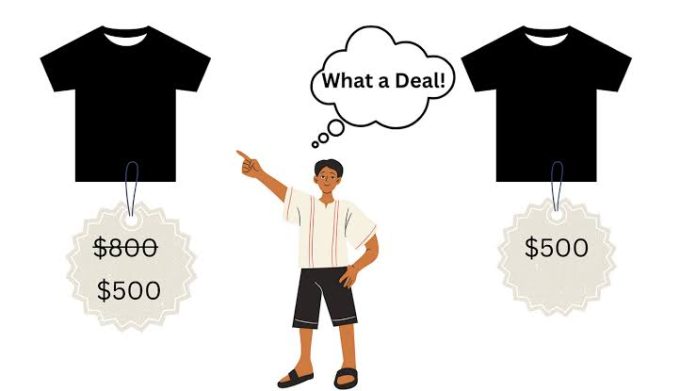Overcoming the “Anchoring Effect”
“Price is what you pay; value is what you get.”
-Warren Buffett
Welcome to another installment in my ongoing series called “Money On My Mind,” where I publish articles to help you deal with the psychological aspects of managing money. Check out past editions of the series here.
 Learn More
Learn MoreWe continue our exploration of cognitive biases by looking at the anchoring bias, which is a leading cause of poor financial decisions.
Read also: How to train your brain to think differently and become more creative (Amazing insights)
Continue reading to learn:
What anchoring bias is
How it causes you to overspend
The impact it has on salary negotiations
How it can lead to poor investing decisions
What is anchoring bias?
Anchoring is when we rely too heavily on either a pre-existing piece of information or the first piece of information presented to us.
This image perfectly explains how anchoring bias leads to overpaying.
Image created by the author using Canva
You walk into a department store, and you see two identical-looking black T-Shirts; one listed at $500 and one “on sale,” marked down from $800 to $500. “You walk over to the shirt on sale and think, wow, I can get this shirt for $300 off.” You should think, “wow, why would anyone spend $500 on a single shirt.”
This is an extreme example, but it highlights how anchoring works. If the first thing you notice is that the “original” price of the shirt was $800, then paying $500 can seem like a deal. Your mind is “anchored” to the original price of $800, so anything less than that seems like a pretty good deal.
Most people love to feel like they are getting a deal. Businesses are not stupid; they understand this. Anchoring is the reason it’s so common to walk into a big box store and see nearly every item “marked down.” It’s also why people are willing to fight and climb over a pile of other consumers during a Black Friday to save $300 on a flatscreen T.V.
Why we are so vulnerable to anchoring bias
The seminal research paper on the anchoring effect was a 1974 paper written by Amos Tversky and Daniel Kahneman. Tversky and Kahneman described anchoring as the tendency to make an estimate starting from an initial value.
To quote the paper:
“Different starting points yield different estimates, which are biased toward the initial values. We call this phenomenon anchoring.”
In the example I gave about the overpriced t-shirt that looked “like a deal” because it was on sale, the original price of the shirt was the anchor, which influences the perception of value for the sale price.
That example undersells the power of anchoring. As Tversky and Kahneman point out, even completely random numbers unrelated to the decision at hand can influence your perceptions.
Tversky and Kahneman describe an experiment where participants in a study were tasked with spinning a “wheel of fortune” style spinner with numbers ranging from 0–100. After spinning the wheel, people were asked to guess the percentage of African countries represented in the United Nations.
What they found was that the number they spun at random was directly correlated to their guess about the percentage of African countries in the U.N. Those who spun a 10 on the wheel guessed 25% of African countries were in the U.N. and those who spun a 65 guessed 45% on average.
Having a random — but relatively high — number in your head before estimating percentages is enough to nudge the human brain into guessing a high number and vice-versa. That’s how simple it is to influence human decision-making.
Anchoring can impact just about every kind of decision you can think of. From something as trivial as guessing how many African countries are represented in the U.N. to life-changing decisions like the length of a prison sentence handed down by a judge.
A 2006 study found that the sentence requested by prosecutors directly impacted the actual sentence handed down by a judge. The more years demanded by a prosecutor, the more years the judge will likely hand out and vice versa. The research also found that the framing effect on sentencing was independent of the relevance of the prosecution’s requests and the experience of the judge. If you’re going to be found guilty of a crime, the best thing you can hope for is a prosecutor who does not ask for the maximum sentence.
Want to win a negotiation? Make the first offer
Those who understand anchoring can use it to tilt the odds in their favor in any financial negotiation.
The most important negotiation of most people’s financial lives is their salary. All wealth is built from income.
Here’s the first rule about negotiating.
Whoever makes the first offer is likely to win the negotiation.
A 2001 paper examined the impact first offers had on the outcomes of negotiations. Here were the three main takeaways from the research:
Whichever party made the first offer had a better outcome
First offers were a strong predictor of the final price
The impact of first offers was consistent for negotiations in person or via email.
Why is the first offer so important? You guessed it, anchoring. If the party who makes the first offer puts forward a relatively high opening offer, all counteroffers will be anchored to that initial offer — which, if it’s a high number, likely means the final number will be high.
When it comes to salary negotiations, employers are inherently at the upper hand because they make the first offer.
The job description of an open position often comes with a salary range. The second you read that the job you are applying for has a salary range of $90,000-$100,000, you have immediately become anchored to that range. Your best-case scenario becomes, “how do I get as close to $100,000 as possible?”
Few people are bold enough to ask for a salary greater than what the employer initially offers. We are afraid that if we ask for more, the employer will revoke the initial offer, which is possible.
Employers win every salary negotiation because they make the first offer. 64% of job applicants take the employer’s first salary offer without making a single counteroffer. We willingly accept the rules they create for the negotiation so it’s no surprise they win.
Car dealerships also use anchoring to tilt the scales in their favor.
It’s an unwritten rule that the sticker price of any car on the lot is not the actual price and that it can be negotiated down. But the sticker price is a powerful anchor that influences any counteroffer your make.
Let’s say the dealer puts a $35,000 sticker price on a car. After some back and forth, they tell you that if you close right now, you can buy the car for $33,500. You feel pretty proud about saving $1,500. Little did you know, they would be willing to sell that car for $30,000. Since your counteroffer was anchored to the sticker price of $35,000, your goal became “how do I get below $35,000” instead of “how do I get the price as low as possible?”
Anchoring causes avoidable investing mistakes
When you start comparing the current price of any asset to the price “you think” it should be, you set yourself up to make bad decisions.
Investors get very nervous when the stock market reaches an all-time high. They assume that a market crash is imminent because they are comparing today’s “high prices” to lower prices of the past and assuming the lower price is somehow more accurate.
I covered this exact topic of investing when the stock market is at an all-time high in my book The Rational Investor; here’s a copy/paste of that page.
If a new all-time high is a sign of an impending market crash, as the pundits would have you believe, we expect investors who put new money in after an all-time high to lose money.
Except they don’t.
Research from JP Morgan outlines the data that shuts down the narrative that you should avoid investing your money when the market hit’s an all-time high.
In their research, J.P. Morgan looked at the total S&P 500 returns from 1988 through April 2021 and found that if you had invested your money on a randomly selected day, your average return on investment after one year was 11.9%.
That’s not bad at all. I’d take a 12% return any time.
But what would your average return have been if you only invested on days when the market closed at a time-high? 14.3%. You would have outperformed by nearly 2.5% if you only invested after the stock market broke a new record.
If we zoom out to a three or five-year time horizon, your cumulative returns from only investing after new all-time highs would continue outperforming.
Data Source: JP Morgan, chart created by the author
If you sell or refuse to invest because your expectation for the stock market is anchored to last year’s prices, you are likely leaving money on the table.
Anchoring can also hurt your investments in the opposite way when you become emotionally attached to your investment. When the price reaches a new all-time high, that new higher price can become what economists call your “reference price,” the price you perceive your breakeven point to be.
A 1998 paper titled “do investors trade too much?” outlines how a homeowner’s expectations for what their house is worth can become anchored to an unrealistic price.
Let’s say you bought your house for $100,000.
$100,000 is your actual breakeven point.
But if the housing market goes bonkers and the price increases to $200,000, eventually, you think of $200,000 as your new breakeven point.
As a result, you might be unwilling to sell for less than $200,000 even if the market dictates a lower price in the future.
Read also: How to speed up your mental processing (must read)
Overcoming anchoring bias
In any negotiation, whether it be salary, buying a car, or anything where the price can be haggled over, the best thing you can do is make the first offer.
If you are put in a position where you need to make a counteroffer, be conscious of the fact that your brain wants to use the initial offer as a starting point and ignore that instinct. Make a counteroffer that is not based on the first offer but is the ideal outcome you want. If the salary range being offered is $90,000-$100,000, but you think you are worth $120,000, ask for $120,000.
If you are considering buying something because it’s “on sale,” take a breath. Don’t focus on price reduction; think like an economist and consider the opportunity cost.
Ask yourself three questions before making a purchase.
Is this a good value or a low price?
Will buying this improve the quality of your life?
What else could you spend this money on?
When it comes to investing, do not get emotionally attached to the price of any asset. Whether it be stocks or housing, realize that the price of any asset is constantly changing. Don’t let your mind be anchored to what the price used to be; all you can do is look at the current market value and make the best decision to buy, hold, or sell based on your circumstances.
For more information and updates join our WhatsApp group HERE
Follow us on Twitter HERE
Join our Telegram group HERE













![The 17 Habits Of Truly Wealthy People That you can easily adopt now [Real powerful stuff]](https://worldfamilydigest.com/wp-content/uploads/2022/02/FA033A84-800B-424D-8DEA-2BB8AD9E91F6-100x70.jpeg)

